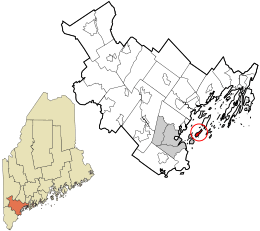Long Island, Maine facts for kids
Quick facts for kids
Long Island, Maine
|
||
|---|---|---|
|
||

Location in Cumberland County and the state of Maine.
|
||
| Country | United States | |
| State | Maine | |
| County | Cumberland | |
| Incorporation | July 1, 1993 | |
| Villages | Long Island Mariner |
|
| Area | ||
| • Total | 33.52 sq mi (86.82 km2) | |
| • Land | 1.42 sq mi (3.68 km2) | |
| • Water | 32.10 sq mi (83.14 km2) | |
| Elevation | 14 ft (4 m) | |
| Population
(2020)
|
||
| • Total | 234 | |
| • Density | 165/sq mi (63.6/km2) | |
| Time zone | UTC-5 (Eastern (EST)) | |
| • Summer (DST) | UTC-4 (EDT) | |
| ZIP Code |
04050
|
|
| Area code(s) | 207 | |
| FIPS code | 23-41067 | |
| GNIS feature ID | 1729676 | |
Long Island is a small island town in Cumberland County, Maine, in the United States. It became its own town, separate from the city of Portland, in 1993. In 2020, about 234 people lived there. Long Island is part of the larger Portland area.
Contents
Island Geography
Long Island covers a total area of about 33.52 square miles (86.82 km2). Most of this area, about 32.10 square miles (83.14 km2), is water. The land area is much smaller, at about 1.42 square miles (3.68 km2).
Island Population
The number of people living on Long Island changes a lot between seasons. While about 200-230 people live there all year, the population can grow to over 700 during the summer. This happens because many people have summer homes on the island.
Long Island has its own elementary school for students from kindergarten to fifth grade. After fifth grade, students travel to Portland for middle and high school.
Population in 2010
In 2010, there were 230 people living on Long Island. These people lived in 99 households, and 70 of these were families. The island had 381 housing units in total.
Most of the people living on the island (93.5%) were White. A small number of people were African American (2.2%), Native American (0.4%), or Asian (2.6%). About 2.2% of the population was Hispanic or Latino.
The average age of people on the island was 52 years old. About 20.4% of residents were under 18. Many residents were older, with 28.7% being 65 years or older.
Island History
Long Island, like other islands in Casco Bay, was first used by Native American people during the warmer months. European settlers started arriving in the 1600s.
In 1732, a man named Col. Ezekiel Cushing bought the island. He was the first European to build a house and live there. When he passed away in 1765, he left the island to his nine children. Soon, more settlers came to the island. They made a living by farming, fishing, and catching lobsters.
Long Island During World War II
During World War II, Casco Bay became an important base for the United States Navy. This base, called Sail, helped protect ships carrying supplies across the Atlantic Ocean.
Special buildings were put up on Long Island. These included a school for navy officers and a pier for navy supplies. There was also a base for seaplanes, which are planes that can land on water. The United States Army Coast Artillery Corps also built two large gun batteries on the island to help protect the harbor of Portland.
After the War and Becoming a Town
After World War II, tourism became very popular on Long Island. Many small shops, a fire station, and an elementary school were built. Every summer, hundreds of tourists, especially from Massachusetts and New York, come to vacation in their summer homes.
Long Island used to be part of the city of Portland. In 1990, Portland changed how it valued properties, which caused property taxes on Long Island to go up a lot. Many island residents felt they were paying too much in taxes compared to the services they received from Portland.
Because of this, the people of Long Island voted to become their own separate town. On July 1, 1993, Long Island officially became the Town of Long Island. The Long Island Historical Society keeps all the news articles and videos about this important event.
See also
 In Spanish: Long Island (Maine) para niños
In Spanish: Long Island (Maine) para niños


